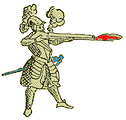A Short Biography
of Champlain
 |
Champlain, soldier and navy captain, 1609
Based on detail of the engraving
Defeat of the Iroquois at Lake Champlain
Champlain,
The Voyages, 1613
National Library of Canada |
Samuel Champlain (born in Brouage circa 1575; died at Quebec,
December 25, 1635), son of Antoine Champlain, a navy captain, and
Marguerite Leroy. Samuel spent his childhood in Brouage, an Atlantic
harbour, in Saintonge, near the salt marshes, where ships were fitted out
for fishing off for the Grand Banks and the coast of Newfoundland.
His career began in the military. In March 1595, he was a
quartermaster in Brittany’s royal army, then he became an assistant to the
billet master. According to military accounting records, in 1597 the Sieur
de Champlain was an ensign or a captain in a company stationed at Blavet,
near Quimper. At the end of the war, he was a billet master.
|
|
Champlain's first voyage to Canada in 1603
|
Unemployed after the war, he left for Spain on a ship belonging to
his uncle Guillaume Allene, also known as "captain Provençal",
a privateer that was at the service of the king of France. Upon his arrival
in Cádiz, Champlain was granted permission to leave for the "West
Indies". He spent two years in the Spanish colonies in Peru and Mexico.
In 1601, he inherited an immense estate from his uncle, near La Rochelle,
and a pension at the court of Henri IV.
Upon the invitation of Aymar de Chaste, who now held the fur trade
monopoly in New France, Champlain boarded Gravé du Pont’s ship as a
volunteer, on March 15, 1603, for his first trip to Canada. Thus began his
Canadian career.
Scientifically inclined, a good observer, an excellent technician, a
writer, illustrator, cartographer and ethnographer, Champlain left us six
works, four of which are about Canada, and 70 drawings or maps. A consummate
soldier and navigator, the author of the Treatise on Seamanship was a
"man of action".
In 1618, before his ninth trip to New France, Champlain submitted
reports to the king and the chamber of commerce in which he proposed a
programme of commercial colonization for Canada, which showed that he was a
visionary and practical administrator. He eventually became the
representative of the viceroys and Cardinal Richelieu, as well as one of the
shareholders in the Company of One Hundred Associates.
From 1603 to 1632, he informed the nobility and the bourgeoisie about
the Canadian colony. The accounts of his voyages, published in four volumes
starting in 1603, reveal only the details of his life as an explorer and his
official role as a colonial administrator. There is nothing on his personal
life and very little on that of his companions.
Champlain’s last work describes, among other things, how Quebec was
taken by English privateers, the Kirke brothers, on July 20, 1629, two
months after the end of the war between France and England. In 1632,
subsequent to the signing of the Treaty of Saint-Germain-en-Laye, Cardinal
Richelieu sent an expedition to Canada to take possession of Quebec.
Over the course of his Canadian career, Champlain crossed the
Atlantic 22 times, travelled 35,000 kilometres and lived on the banks of the
Saint Lawrence throughout the year, until his death at Quebec on December
25, 1635.
|